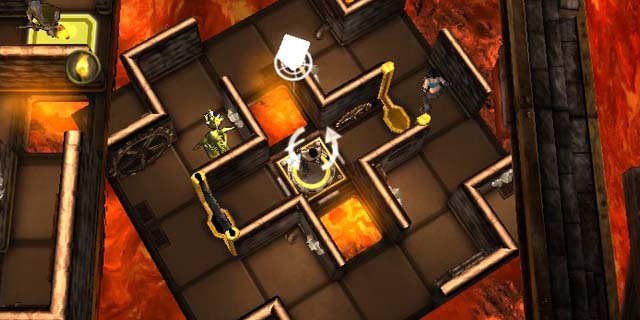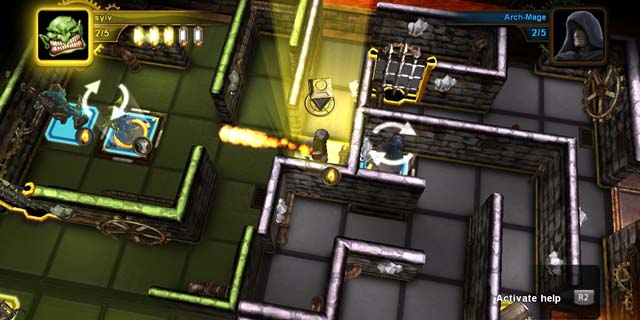
Recently, a lot of board games have made the jump to digital releases, and with mixed results. Dungeon Twister is the latest, and while it is an admirable conversion, it seems to lose something in the translation.
The unplugged perspective
Dungeon Twister is an anomaly in board games: it’s beer-and-pretzels silly fun like many fantasy games, but the two-player head-to-head format gives it Chess-level intensity. Wizards and dungeons give it that D&D-like storytelling feel, but these are set pieces in a forced context. It’s really about the labyrinth providing varied boards for play.
In some ways, it can’t really decide what it wants to be, but generally, when it comes down to it, it maintains the needed balance. – Graham Russell
In Dungeon Twister, you and an opponent are trapped in a dungeon made up of eight rooms arranged in a 4-by-2 pattern and tasked with scoring five Victory Points first (VP). You gain VP by either escaping the dungeon or killing your opponent’s characters. Each kill or escape is worth one point, subject to a few item or unit modifiers. Turns consist of anywhere from two to five action points, depending on the action card you play for that turn.
Each player has eight unique characters to control, though four are left inactive in the dungeon until the room they are in is revealed. Each character has varying combat and movement attributes along with an array of special abilities. For instance, the Wall-Walker can walk through walls at the cost of one action point, while the thief can walk over pit traps and even act as a bridge for other characters to do the same. Then of course, there’s the Wizard’s ability to levitate over both pit traps and opposing characters and wield a fire wand to insta-kill any enemy in a direct line from him, no matter the distance.
The fire wand is one of the six items that will also be placed in the dungeon. The others range from treasure that gives a bonus victory point if a character escapes while holding it, to a sword and shield which increase the holding character’s offense or defense.

The rooms themselves have more obstacles than just walls and pit traps. There are portcullises that can be open or closed, and a rotation square where characters can stand and rotate the rooms to their advantage. Each and every action costs one point, and it is up to you to determine the best way to use them.
A logical conversion
The game makes sense in digital form. While a lot of the “fun” of the physical version is flipping and twisting board pieces, that’s not actually an easy task while keeping pieces in place. With the context-sensitive menu options and a nice turning mechanic, this game’s easier to play digitally. That is, of course, if you can get over the lack of local play and the most awkward fighting and celebration animations in the industry. – Graham Russell
As I’ve stated before, you can kill your opponents if you prefer fight over flight. Combat is a fairly simple affair, as each player selects a combat card from their hand (each card is discarded after use, so there’s strategy in choosing whether to reserve your best cards or not) and adds the value of the card to the native combat strength of their character. If you lose the battle, that character is wounded and can no longer perform any actions unless healed by a Cleric. You must be fast with your Cleric though, as the next time a wounded character loses a battle, it is killed and removed from the board.
It’s fairly complicated at first glance, which is why it’s a good thing there’s a great tutorial that will walk you through each aspect of the game. Aside from the tutorial, there’s a single-player mode where you can face off against the AI, though games like this just lose so much of their value when you play alone. It works well, but it quickly gets boring. The multiplayer is where a game like this needs to be focused. I’m happy to report that the multiplayer does work well, technically. Unfortunately, even this mode loses its luster fairly quickly. It just seems that, while there are no flaws in this recreation, this game loses a lot of its appeal when the face to face aspect is removed.
Dungeon Twister is a hard game to review, because while it isn’t a flawed game, it isn’t compelling either. If you have some people to play with you’ll enjoy Dungeon Twister, though I can’t say for how long.
Pros: Well-executed, great strategy
Cons: Just feels like it’s missing something



















